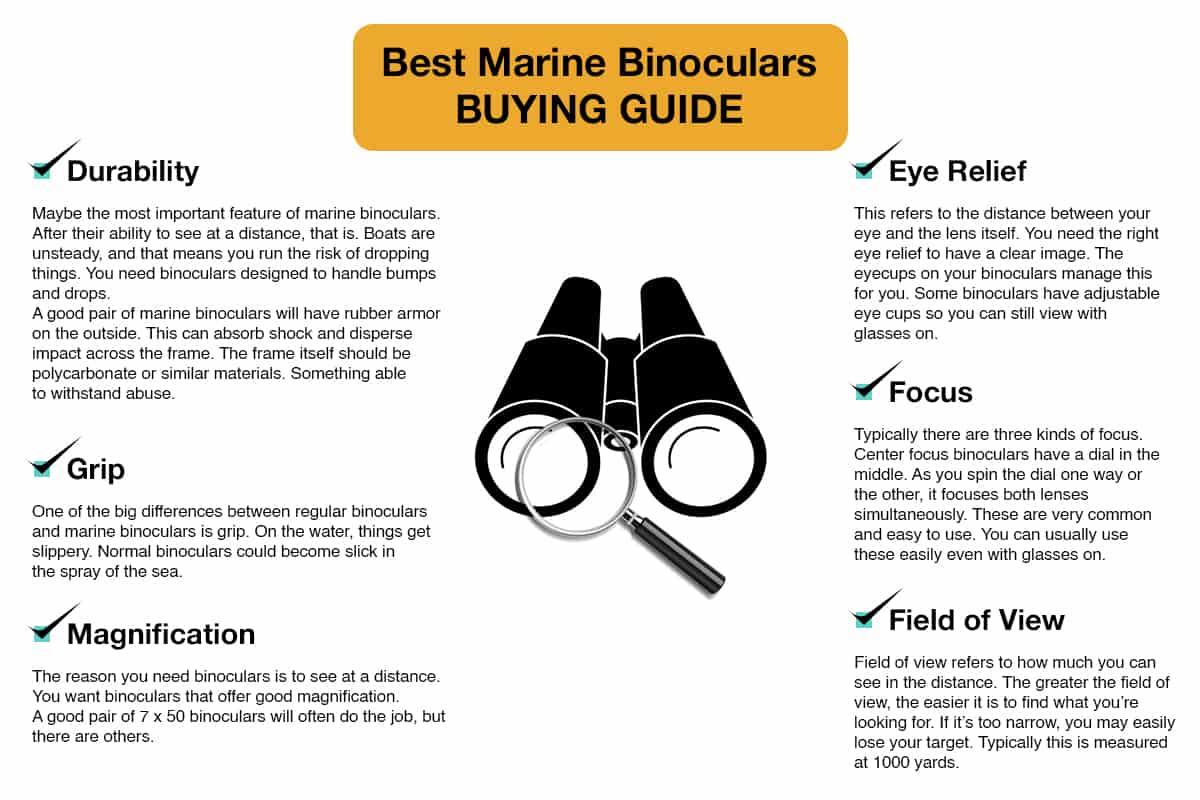Reviewing The Best Marine Binoculars of 2024
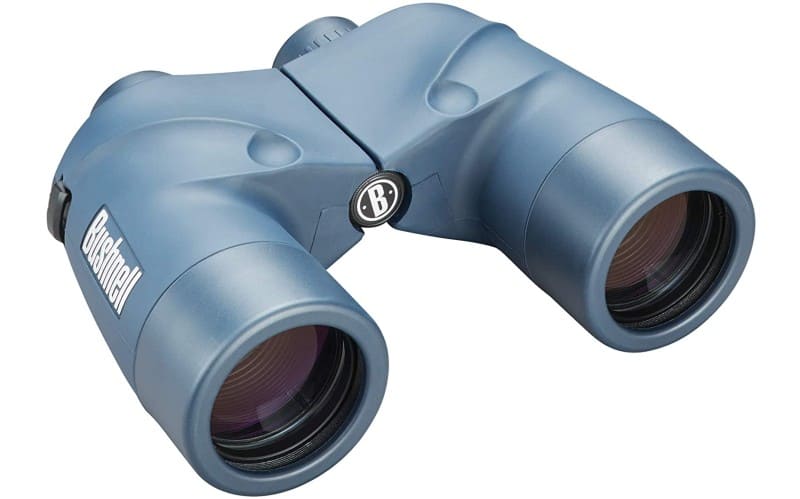
Bushnell 7x50 Marine Waterproof Binoculars
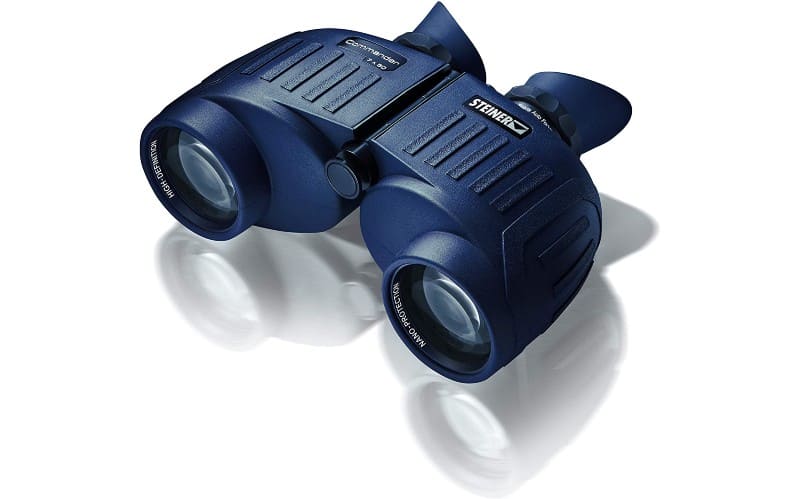
Steiner Commander Marine Binoculars
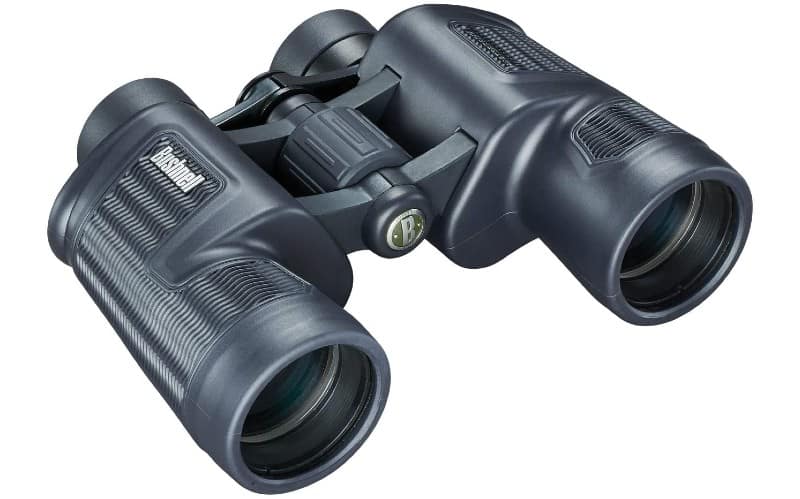
Bushnell Fog Proof and Waterproof Binoculars
On land you may need a pair of binoculars just for fun. If you’re bird watching or hiking, they can be a real help. At sea, they’re much more. Marine binoculars can enhance your vision to improve safety on a boat. They can improve your field of view and allow for enhanced warning of danger. A good pair of marine binoculars can help you avoid other vessels, rocks, and more. They can also assist in finding landmarks, points of interest, and passengers overboard.
If you want to make sure you’re getting the best marine binoculars, we can help. Let’s take a look at the best binoculars on the market today.
Bushnell 7x50 Marine Waterproof Binoculars

If you want the best of the best, you need to look at Bushnell. These 7×50 marine binoculars are recommended by the U.S. Coast Guard. Check out the decks of 100 ships and you’ll find Bushnell binoculars on most of them.
They are corrosion resistant for extended use in marine environments. Naturally they are waterproof and fog proof as well. The rubber coating is non-slip and non-skid. It can absorb impacts as well, helping prevent damage.
A Bak 4 prism type makes for crystal clear images. This makes for superior image clarity and image quality. The optics are fully multi-coated and UV protected. They offer individual focus for improved clarity. They also provide a wide field of view so you don’t miss anything. There’s even a limited lifetime warranty.
Steiner Commander Marine Binoculars

If you’re looking for some top of the line marine binoculars, look here. Steiner Commander are at a higher price point but they offer superior quality.
Steiner has gone all out to make these the best, last and only pair of binoculars you need. That means a high-impact rubber armor coating to prevent damage. It’s made of a substance called NBR rubber. That stands for nitrile butadiene rubber. It’s durable and highly resistant. The grip is ergonomic and comfortable. No need to worry about it slipping in rough weather.
The Makrolon polycarbonate body may be the most rugged on the market. These binoculars can take a serious beating. They can endure 11 Gs of force and still perform. To put that in perspective, they show a pair being run over by a car in their ad material.
The fully multi coated lenses feature a protective hydrophobic molecular nanocoating. It ensures the lenses are the clearest and cleanest you will ever see. Water, fog, dust, snow and even fingerprints come right off.
There is a sports auto focus system good from 20 yards and beyond. Whatever you look at instantly comes into focus. No need to fumble with dials, and it also frees up a hand in case you need it. You’ll never experience barrel distortion.
All Steiner products come with a heritage warranty. That means if there is a defect in the binoculars you can have them repaired or replaced forever. If you want to go all out, you can opt for the model that features a global compass. It’s an investment, to be sure, but they may be the best binoculars you’ll ever use.
Bushnell Fog Proof and Waterproof Binoculars

For budget conscious boaters, Bushnell has your back. The same quality and reputation you expect from Bushnell doesn’t have to break the bank. These 8×42 binoculars offer superior magnification at an amazing price.
The grip is non-slip to handle rough and wet conditions. They’re waterproof and fog proof to ensure crystal clear visibility. The tubes are o-ring sealed and purged with nitrogen gas.
There is a center focus knob for easy adjustment. Eyecups are also adjustable for users who wear glasses.
At under two pounds, these are very comfortable to carry and use. They also feature a strap and carrying case for portability.
Canon 10 x 30 Image Stabilization Binoculars
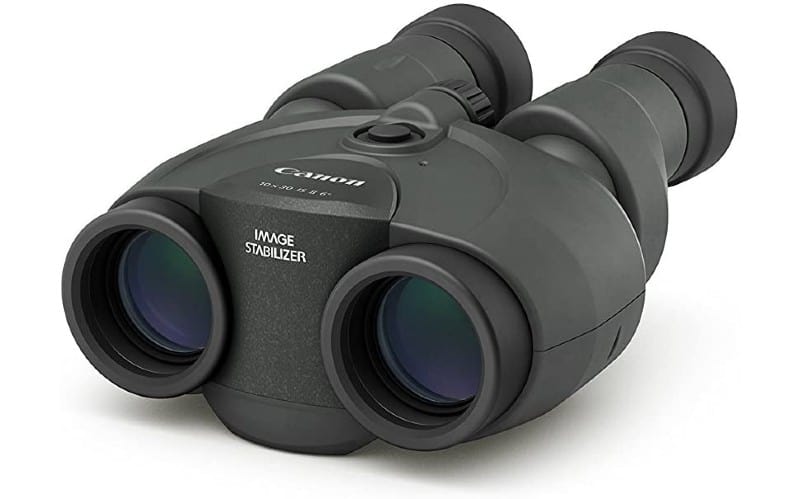
At 10×30, Canon offers standout magnification compared to many other binoculars. The issue with image stabilization is taken care of. Canon uses their image stabilization optics technology. Press a button and shaky, wobbly images are smoothed out instantly. Normally you’d need a tripod for steady viewing at these magnifications.
To enjoy the benefits of these binoculars you do need batteries. They take a pair of AA batteries. The lens features a field flattener. This means you get full, edge-to-edge images with no distortion. No worries about things at the edge of view looking warped or blurry.
The eyecups are extremely large. That can be a benefit for some and a problem for others. It depends on your personal preferences.
These are not specifically marine binoculars, you need to keep that in mind. They’re not meant to handle wet conditions. However, their superior range and stability is a real plus. If you’re a casual boater looking to just have fun with your binoculars, try these.
Vortex Optics Crossfire Marine Binoculars
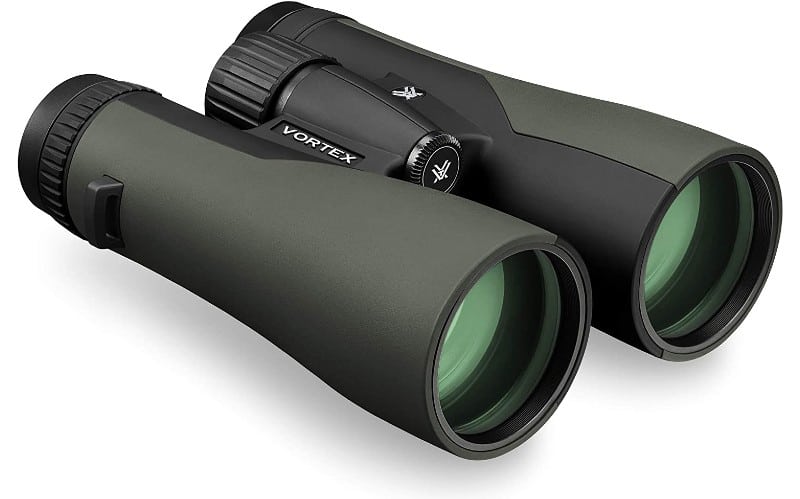
If you need compact binoculars with exceptional power, look here. The Vortex Optics Crossfires use a roof prism type. That means a streamlined look in a small space. They offer 12X magnification, blowing many others out of the water. They offer a 50mm objective lens diameter to provide a solid field of vision.
The eyecups are easily adjusted if you wear glasses. The multi-coated lenses can handle even low light conditions. The tubes are nitrogen purged and o-ring sealed. That renders them fully waterproof and fog proof.
The body is durable and rubber armored. The grip is solid and non-slip, even when wet. If they do fall, it can absorb a decent impact to keep them safe.
Vortex offers some good extras with the Crossfire model. You’ll get a binoculars case for storage. There’s also a case harness. There’s a lens cloth and a rain guard eyepiece cover as well.
Hooway Marine Binoculars
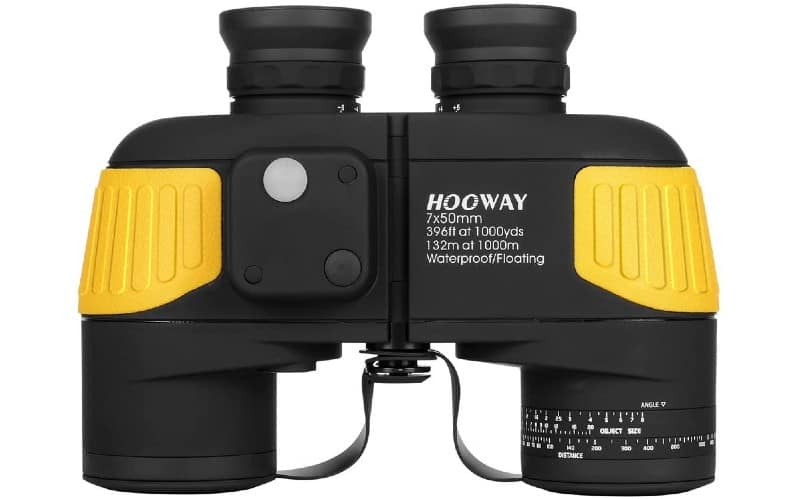
Hooway combines great value and great features. That makes Hooway a fun alternative to some more popular brands. The field of view lays many others to waste at nearly 400 feet at 1000 yards.
Designed with marine use in mind, these binoculars float in water. Obviously that means they’re completely waterproof as well. Sealed with o-rings and nitrogen purged, they can handle the wettest conditions.
Hooway has included an illuminated compass. There’s also a rangefinder. If you like all the bells and whistles, this is a good option. Their rugged design means they can handle a drop on the deck as well. They’re designed to meet military specs. That means a non-slip rubber armor. They won’t slip easily from your hands, and if they do, the frame is tough.
Plus, check out the colors. The yellow may seem a little out of place, but if you drop them in poor light conditions, you’ll be thankful.
Finally, there’s even a tripod mount. If you’re looking for some steady viewing, Hooway has you covered.
Nikon Ocean Pro Binoculars
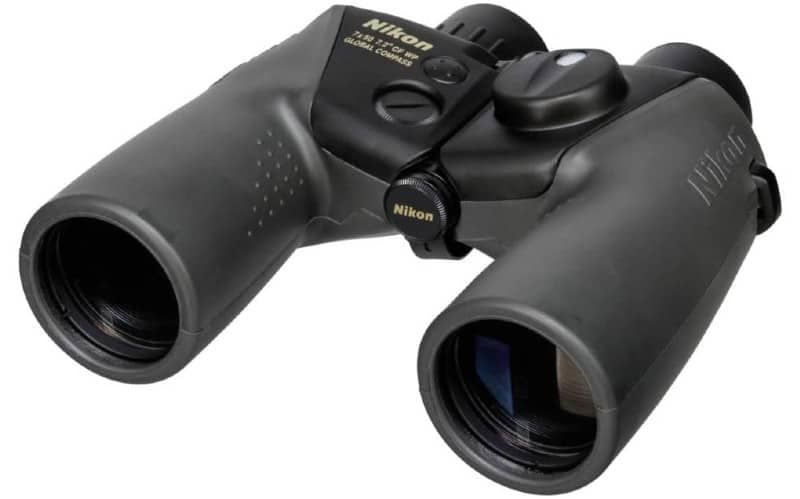
Right away you can tell the Nikon Ocean Pro is a good choice. Nikon has been in the optics game for over a century now. Few companies can be considered as reliable or trustworthy. The Ocean Pro waterproof and fog proof binoculars don’t disappoint.
If you want a reliable pair of marine binoculars, these are a great choice. For sailors who don’t need a lot of extras and gadgets, Nikon has you covered. The Bak 4 porro prism offers excellent and clear viewing. You can rest assured you’ll see well in even low light conditions. There is a built-in illuminated compass as well.
If you want to go even more bare bones, Nikon has a model with no compass. The body is polycarbonate and rubber coated. It can handle some abuse when things get rough. And of course, it’s also waterproof. The nylon strap included will keep them afloat if they do slip into the sea.
Barska Deep Sea Marine Binoculars
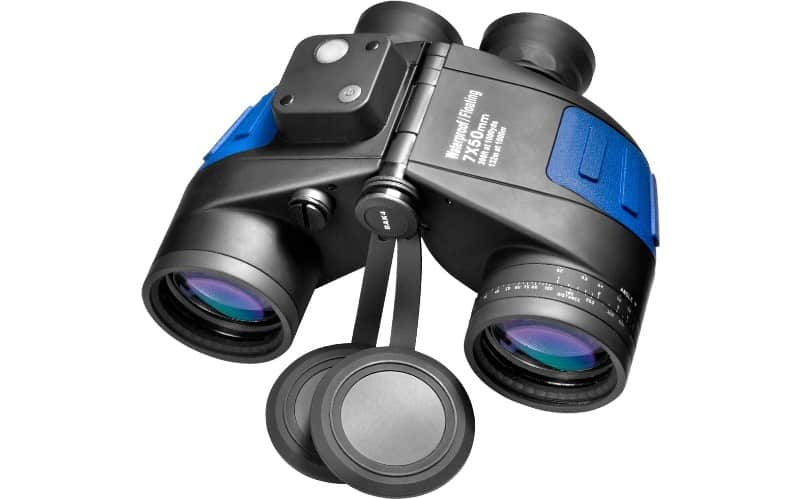
Barska’s deep sea marine binoculars offer up amazing value. At less than half the price of similar models, these are a great choice. They feature an internal compass and a rangefinder. Like any good pair of marine binoculars they can handle weather conditions. They’re both fog proof and waterproof. They are O-ring sealed and dry-nitrogen purged. No moisture is getting into these.
If the seas get too rough, don’t worry. Barska’s binoculars even float. The rubber coating offers a non-slip grip. It’s meant for marine use so even when wet it won’t be hard to hold.
The field of view is exceptional. At 1000 yards you have nearly 400 feet in your field of view. That’s thanks to a reliable 50mm objective lens diameter. The Bak 4 fully multi-coated optics offer ideal viewing sunup to sundown. The company also offers a limited lifetime warranty.
Steiner Military Marine Binoculars
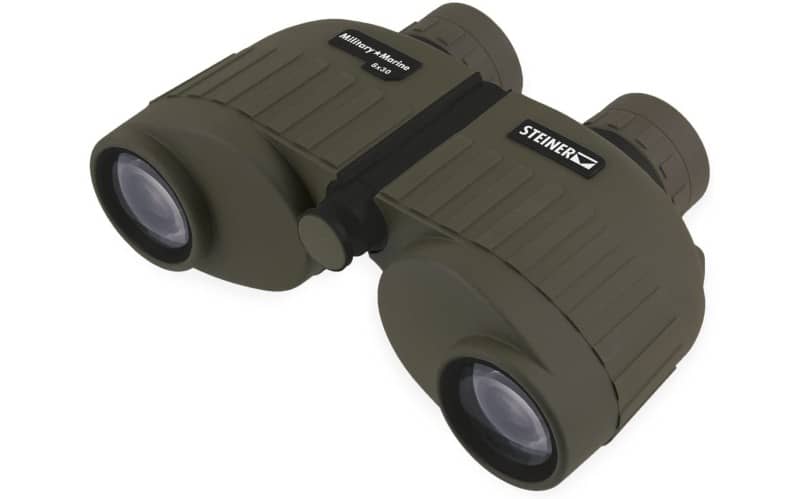
Steiner offers military optics and style to fit your budget. The price point is on par with many models that offer fewer features. The style is rugged but impactful. The body is made of a polycarbonate. It’s designed to handle some abuse. The lenses are fog proof and waterproof. From smooth sailing to rough seas, these will get the job done.
With an 8 times zoom and a wide field of view, these are some of the best marine binoculars you will find. They feature a sport auto focus to allow quick, clear viewing. Floating prism technology is used inside the binoculars. Combined with a flexible silicone mount, if these fall you should have no worries. They’re designed to withstand shock and even severe impacts. Up to 11 Gs, in fact.
Steiner offers a lifetime warranty to cover defective parts. They will repair or replace a defective pair forever. It’s worth noting that it doesn’t cover damage.
Vortex Optics Viper Binoculars
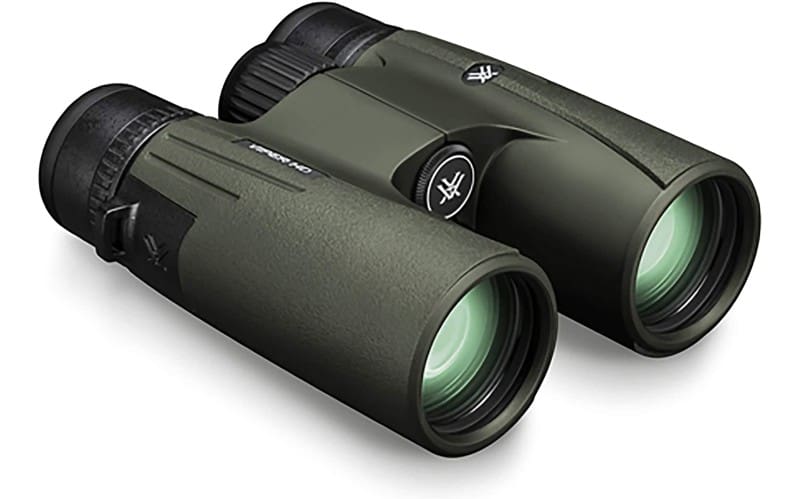
The Vortex Optics Vipers are small but mighty. The lenses are coated in an ultra-hard substance called Armortek. It’s meant to stand up to serious abuse without scratching. The total weight of the 8×42 model is just 24.5 oz.
The grip is non-slip. That makes it ideal in rough, wet conditions. They’re also fog proof and waterproof. The O-ring seal holds argon gas within. You’ll be able to enjoy a clear field of view in all conditions.
Fully adjustable eyecups let you use them with or without glasses on. There’s also a chest harness for easy carrying. Anti-reflective lenses ensure clear images even in low light.
Fujinon Marine 7x50 Binoculars
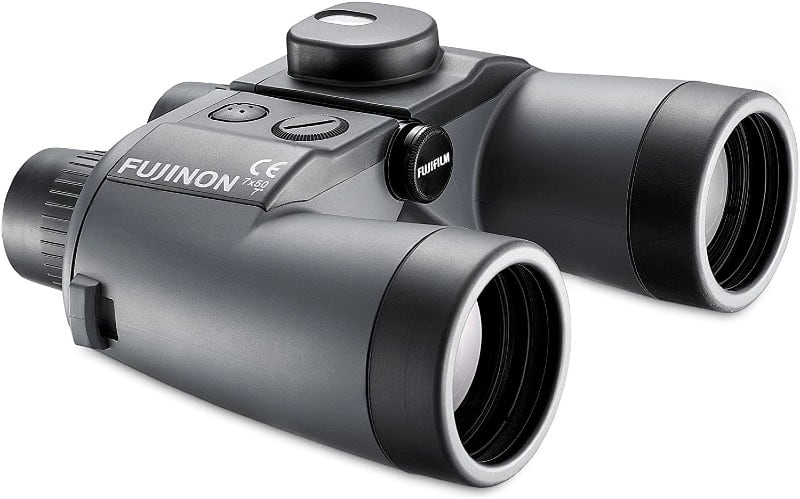
Made by camera makers Fujifilm, the Fujinon marine binoculars are top notch. With a fully waterproof design they also float with the added strap. They are extremely lightweight for the size, and easy to handle.
The price point for the Fujinon Marine is much lower than some similar models. They feature a world compass and individual focus. It also features a porro prism optical design.
There’s an 18mm eye relief to give some added length. The left eyepiece offers a clear view of the compass and reticle display. In darker conditions, there’s an LED nightlight built in. The control and battery are on the right. That means your compass isn’t suffering any electrical interference. The company also offers a 5-year limited warranty.
Things to Remember
Marine binoculars are different than terrestrial binoculars. You could use any old binoculars at sea, but it may not be a good idea. At the very least, you’ll need high-quality hunting binoculars. Ones specifically designed to handle harsh conditions and bad weather. There are a handful of features you want to look for.
Durability
Maybe the most important feature of marine binoculars. After their ability to see at a distance, that is. Boats are unsteady, and that means you run the risk of dropping things. You need binoculars designed to handle bumps and drops.
A good pair of marine binoculars will have rubber armor on the outside. This can absorb shock and disperse impact across the frame. The frame itself should be polycarbonate or similar materials. Something able to withstand abuse.
You want lenses that have been coated to handle scrapes as well. One ill-placed scratch on a lens can really ruin your marine binoculars. Sometimes paying a little extra is what you need to do.
Grip
One of the big differences between regular binoculars and marine binoculars is grip. On the water, things get slippery. Normal binoculars could become slick in the spray of the sea. Good quality marine binoculars feature non-slip grips. The coating should be pliant but not sticky feeling. You want to be comfortable holding them.
Magnification
The reason you need binoculars is to see at a distance. You want binoculars that offer good magnification. A good pair of 7 x 50 binoculars will often do the job, but there are others.
It’s good to be able to understand what the numbers mean when buying binoculars. In this case, 7 is the magnification. So you’ll have a 7x magnification on whatever you are looking at. The 50 refers to a objective lens diameter of 50 mm. The larger the objective lens diameter, the better you can see things. Larger objective lens diameters let in more light. But the trade off is weight. At some point, lenses get too big. So a 50mm objective lens diameter is often a good size for marine use.
When it comes to boating binoculars, 7×50 is an average. You can find other sizes that work well also. It depends on the other features and how you wish to use them.
Getting too high a magnification can be troublesome. It’s great to see further away. But it becomes harder to manage. Keeping things in view at a greater magnification is harder to do. This is why 7×50 is so common. For most boaters, it is the ideal mix to ensure clear viewing.
Eye Relief
This refers to the distance between your eye and the lens itself. You need the right eye relief to have a clear image. The eyecups on your binoculars manage this for you. Some binoculars have adjustable eye cups so you can still view with glasses on. If the eyecups are not adjustable, it can be hard to use binoculars with glasses.
Focus
Typically there are three kinds of focus. Center focus binoculars have a dial in the middle. As you spin the dial one way or the other, it focuses both lenses simultaneously. These are very common and easy to use. You can usually use these easily even with glasses on. One of the big upsides to center focus is range. You can focus easily on things even close up.
Another kind of focus is individual focus. This allows you to focus each lens separately. Doing this allows you to have greater clarity. It can be harder to focus on things that are close up, however.
Lastly, you may find autofocus binoculars on the market. As the name suggests, these try to automatically focus on the object ahead of you. They can be frustrating, however. Many phone cameras use autofocus. No doubt you have experienced it trying to focus on the wrong thing. That is a problem with binoculars as well. If there is more than one object in view it may focus on the wrong one.
Field of View
Field of view refers to how much you can see in the distance. The greater the field of view, the easier it is to find what you’re looking for. If it’s too narrow, you may easily lose your target. Typically this is measured at 1000 yards. Your field of view is how many feet you can see across the horizon at 1000 yards.
Sometimes field of view is explained in degrees. Every degree in a field of view represents 52.5 feet. You may find binoculars that offer you 6 degrees of view, which would be 315 feet.
As magnification increases, field of view decreases. Most boating binoculars will offer a field of view between 300 feet and 350 feet.
Optics
For people not into the technical aspects, optics can be confusing. The words “porro prism” and “Bak 4” don’t mean a lot.
Bak 4 is something called Barium Crown Glass. It is high quality glass that makes high quality prisms. It transmits light very well with little being lost.
Bak7 is a similar product but it is less dense. It is cheaper and doesn’t do the job as well. Bak 4 is the superior choice if you want high quality images.
Porro prism is a kind of prism used in many binoculars. It’s named for its inventor, Ignazio Porro. Light enters through the front lens of the binoculars. It hits a prism at the back of the tube. That prism directs the light in a zig zag pattern to another prism. That prism then sends it to the ocular lens where your eye is located. This can offer very clear, 3D images. They also provide a greater field of view of depth perception.
You can tell if binoculars use porro prisms just by looking at them. If the lens where you put your eye is not directly in line with the lenses at the end, it’s a porro prism. If all the lenses line up, then that’s a roof prism.
Roof prism binoculars are H-shaped. Everything lines up straight. These binoculars tend to weigh much less than porro prism ones. They can be smaller and easier to carry around.
The prisms inside of a roof prism pair overlap. Though they are lighter and smaller, they are also more expensive.
Waterproofing and Fog Proofing
This is one of the big points for marine binoculars. Normal binoculars often are not fog proof and waterproof. But if moisture builds up in binoculars, they can be rendered useless. The moisture condenses on the lenses inside and you can no longer see. This is a constant hazard on the water.
Good quality binoculars are sealed with o-rings. The inner tubes are then filled with gas. This is often dry-nitrogen but sometimes argon is used. The gas changes the atmospheric pressure in the tubes. Because the tubes are under pressure, it prevents moisture from entering. Nitrogen cannot hold moisture, so these binoculars stay dry internally.
The outside lenses can obviously still fog up and get wet. Fortunately, it should be easy enough to wipe them clean.
In terms of waterproofing, you may need to read carefully. No binoculars are going to be fully waterproof. Like watches and cameras, at a certain depth the pressure will become too much. Hopefully, you never drop your binoculars fully in the water so they can sink. But if it happens, they may fail at a certain depth.
Buoyancy
On the water, you always risk losing something overboard. That’s why we have PFDs for passengers and crew. But your binoculars may need something as well.
Not all marine binoculars can float. In fact, many do not. The materials needed to make them are generally not buoyant. There are some models that will float on their own. However, many rely on buoyant straps. Foam wrist or neck straps that act as a PFD for your binoculars. If you don’t have binoculars that float on their own, make sure you get a strap that does.
Extras
There are many extra features that modern marine binoculars can offer. One of the most common is a compass. Simple models may just have a small compass on top you can read. Others will have an electronic compass. The read out is displayed over your field of view inside the lens.
Imagine stabilization is another feature of some binoculars. At the maximum distance, viewing can be tricky. Minor shakes in your hand can cause the image to rock right out of view. Stabilization helps even out these minor movements. That improves image clarity. Also, your ability to hold an image in focus.
Rangefinders are another feature that some binoculars may offer. An infrared system is used to measure the distance between you and an object like another boat. It will display on the rangefinder reticule inside the binoculars.
Some models include what is known as an inclinometer. While a rangefinder shows the distance, an inclinometer shows angle of incline. That means the elevation of something, or how high up it is compared to you.
Price
As with most things in life, you need to be aware of the price of binoculars. Buy the best you can afford at the time is always a good piece of advice. Marine binoculars can greatly range in price. Some may be around $100. Others can cost over $1000.
Only you know for sure what you need from a pair of marine binoculars. If it’s just something you want for fun, maybe you don’t need to invest a ton. But if you’re a serious boater and work on the water, you’ll want a reliable pair. Higher quality binoculars often cost more.
More expensive doesn’t always mean better. Check the features and find the ones that give you everything you need. There are many options that are still affordable and do a good job.
Categories: Boats
